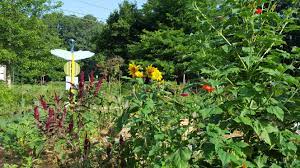Did you know there is a great deal to be done in your yard in August? Yes, that’s right, despite the heat, August is the perfect month for some much needed yard work.
According to CostaFarm.com, you can maintain your late-summer garden with these easy tips for your August garden. Here are a few of our top tips from their suggestions.
Tips
1. Divide Perennial Flowers
August is the best time to dig and divide perennial flowers in your garden (such as hosta, Oriental poppy, lily, daylily, ornamental grasses, and bearded iris). Use a spade to lift the plant from the ground being careful to damage the root ball as little as possible. When the clump is out of the ground, use a large garden knife or spade to cut it into smaller pieces. Then, replant the smaller pieces or divisions as soon as possible.
2. Add Fall Color
Give your flower border a late-summer injection of color by adding a generous helping of chrysanthemums. Available in an almost unlimited selection of colors, shapes, and flower forms, chrysanthemums go well with any garden decor. Plus, because they are sold in bud or bloom, they’ll add instant impact to pots, planters, or flower borders. Their nectar-rich flowers attract a variety of colorful pollinators including migrating Monarch butterflies. Mix single- and double-flowering varieties with asters, pansies, and other fall bloomers.
3. Replace Annual Flowers
By late summer, some annual flowers may look a bit worn out. Give your pots and planters a makeover by tucking in fresh, ready-to-bloom cool-season annual flowers that will keep the color show going through the fall. Just gently pull out dead or dying annuals, mix in a bit of fresh soil, and drop in the replacement. It’s that easy!
4. Wage War on Weeds
If you’ve been putting off weeding chores in the garden, August is the time to finally get busy. That’s because, as the growing season winds down, both annual and perennial weeds start to produce thousands of seeds that will germinate in your garden next spring. If left unchecked, these pesky invaders become extremely difficult to eliminate. The best time to weed is right after a rain when the soil is still moist. If rainfall is scarce, irrigate your garden thoroughly the night before you start your attack. You can pull weeds by hand or use a hoe. Just be sure to remove the roots. Weeds such as crabgrass or purslane quickly regenerate from any root left in the soil. As soon as you have the weeds removed, cover the area with a thick mulch of compost, straw, leaves, or shredded bark.

5. Plant Perennials and Shrubs
Late summer is a perfect time to plant perennials and flowering shrubs in many areas. They’ll take root during the cool, moist fall weather and be ready to pop into bloom next spring and summer. Some good candidates to plant now include hydrangeas, daylilies, lilies, sedums, ornamental grasses, peonies, and bearded iris. Just be sure you keep your new plants well watered if the weather is hot and dry. Mulching the beds also helps preserve soil moisture. In northern states, cover new plantings with a protective blanket of straw or leaves during their first winter. Wait until the ground freezes in late autumn before covering.
Need help? Call us! Stone Creek is your complete landscape solution regardless of your property’s current condition. Whether you’re looking for maintenance, design and install, or just a splash of seasonal color, our skilled and professional crews are here to help.
